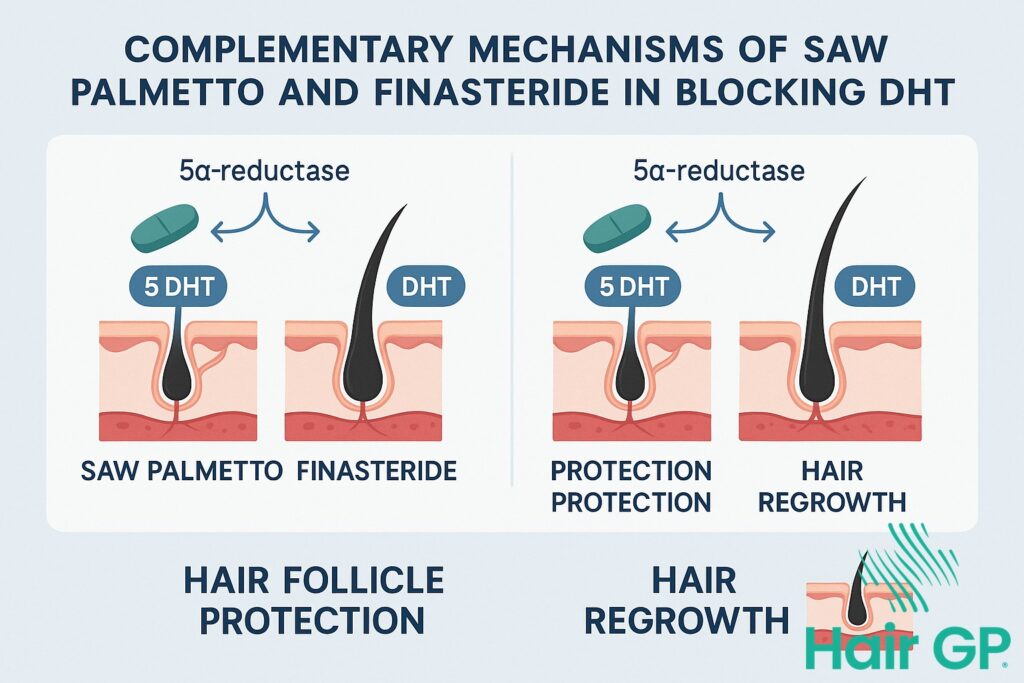Introduction
For those seeking comprehensive hair loss solutions, can you safely use saw palmetto alongside finasteride? This question has become increasingly relevant as men & women with androgenetic alopecia explore ways to maximise their treatment outcomes. Both substances work as DHT blockers, targeting the hormone responsible for male pattern baldness, but through different mechanisms that may potentially complement each other.
The combination of a prescription medication like finasteride with a natural supplement such as saw palmetto represents an intriguing approach to hair restoration. Whilst finasteride has extensive clinical backing, saw palmetto offers a gentler alternative that some patients find appealing. Understanding whether these treatments can work together safely requires careful examination of their interactions, side effect profiles, and the scientific evidence supporting combined use.
This comprehensive guide explores the mechanisms behind both treatments, analyses safety data from clinical studies, and provides practical guidance for optimising your hair loss protocol. We’ll examine potential drug interactions, discuss realistic expectations for results, and help you determine when professional medical consultation is essential for your specific situation.
Key Takeaways – TL/DR
- Combining saw palmetto with finasteride is generally considered safe with no major drug interactions reported in clinical studies
- Both treatments work by blocking DHT but through slightly different mechanisms, potentially offering complementary benefits
- Most healthcare providers recommend starting with one treatment and monitoring results before adding the second
- Side effects may be cumulative when combining treatments, particularly regarding sexual function
Understanding Hair Loss Treatment: Finasteride vs Saw Palmetto
Understanding the fundamental differences between finasteride and saw palmetto reveals why combining these treatments interests many experiencing hair loss. Whilst both target DHT, the hormone responsible for androgenetic alopecia, their mechanisms and potency differ significantly, potentially creating complementary effects when used together.
How Oral Finasteride Works
Oral finasteride, marketed as Propecia for hair loss, functions as a selective type II 5-alpha reductase inhibitor, reducing serum DHT levels by approximately 70%[1]. This FDA-approved medication blocks the enzyme converting testosterone to dihydrotestosterone, protecting hair follicles from miniaturisation. At the standard 1mg daily dose, finasteride typically shows visible results within three to six months, with peak effectiveness around twelve months[2].
Saw Palmetto’s Natural Approach
Serenoa repens, commonly known as saw palmetto, originates from the southeastern United States and offers a gentler approach to blocking DHT. This botanical extract contains fatty acid compounds that may inhibit both type I and type II 5-alpha reductase, though less potently than finasteride[3]. Dietary supplements typically provide 320mg daily, appealing to those seeking alternative treatments without prescription requirements. Whilst saw palmetto’s DHT reduction is modest compared to finasteride, its broader enzyme inhibition profile and potential anti-inflammatory properties make it an intriguing complementary option for comprehensive hair loss management.
Saw Palmetto and Finasteride: Safety of Combined Use
The safety of combining saw palmetto and finasteride remains a primary concern for patients seeking comprehensive hair loss treatment. Current evidence suggests these treatments can be used together safely, as they target DHT through different mechanisms without significant drug interactions. However, proper medical supervision ensures optimal safety when implementing combination therapy.
Clinical Evidence for Combination Safety
Research examining the concurrent use of saw palmetto and finasteride has not identified major pharmacokinetic interactions between these compounds [3]. The finasteride group typically shows 65-70% DHT suppression systemically, whilst the saw palmetto group demonstrates localised 5-alpha reductase inhibition without significantly affecting serum hormone levels. When compared to placebo group outcomes, combination therapy users report similar safety profiles to monotherapy patients. Healthcare providers should consult current drug-interaction-checker databases, though both substances primarily undergo hepatic metabolism through different pathways, minimising interaction potential.
Monitoring for Cumulative Effects
Whilst generally safe, combining treatments necessitates vigilant monitoring for potential additive side effects. Sexual dysfunction, though uncommon, may theoretically increase when both DHT blockers are used simultaneously [4]. Patients should regularly consult their doctor or pharmacist about any changes in libido or erectile function. Hormone levels typically don’t require routine monitoring, as saw palmetto doesn’t significantly affect systemic androgen concentrations. Healthcare provider supervision remains essential for adjusting dosages and identifying individual responses to combination therapy, ensuring treatment remains both effective and safe throughout the treatment period.
Drug Interactions and Side Effect Considerations
Understanding potential drug interactions and side effect profiles is essential when combining saw palmetto with finasteride or other medications. While saw palmetto generally demonstrates a favourable safety profile, combining it with pharmaceutical treatments requires careful monitoring for both additive effects and unexpected interactions that may affect treatment outcomes or patient wellbeing.
Common Side Effects to Monitor
Sexual dysfunction remains the most reported concern when using DHT-blocking substances together. Finasteride alone carries a 2-8% risk of erectile dysfunction and decreased libido [5], whilst saw palmetto may theoretically enhance these effects through similar mechanisms. Depression and mood changes, though less common, warrant attention as finasteride carries FDA warnings regarding potential psychiatric effects. Physical symptoms including headaches, gastrointestinal distress, and mild dizziness may occur more frequently with combination therapy, particularly during initial treatment phases.
Interactions with Other Medications
Saw palmetto may interact with anticoagulants and antiplatelet medications due to its potential blood-thinning properties [6]. Patients using hormone therapies should consult their pharmacist or Doctor, as both treatments affect hormonal pathways. Other medications requiring consideration include NSAIDs, which may enhance bleeding risk when combined with saw palmetto, and supplements affecting hormone metabolism. Always inform healthcare providers about all substances being used concurrently.

Male Pattern Baldness: Optimizing Your Treatment Protocol
Managing male pattern baldness effectively requires a strategic approach to combining treatment options for optimal results. Patients with androgenetic alopecia can maximise hair density through carefully planned combination protocols that balance efficacy with safety.
Starting Your Combined Treatment
The best way to start combination therapy begins with a comprehensive baseline assessment. Talk to your specialist about introducing treatments gradually rather than simultaneously—typically beginning with a consistent daily dose of oral medication before adding topical solutions after four weeks. This stepped approach helps identify which treatment provides specific benefits whilst monitoring for any adverse reactions. Establish a morning routine for topical applications and evening schedule for oral medications to ensure consistent adherence.
Tracking Progress and Adjusting
Document your progress through monthly photographs taken under identical lighting conditions to accurately assess hair density improvements. Most patients observe initial results within three to four months, though significant changes typically require six to twelve months of daily treatment. Continue monitoring scalp response and adjust your dose or application frequency based on results and tolerability, always maintaining open communication with your healthcare provider throughout the treatment-timeline.
Hair Growth Results: What to Expect from Combination Therapy
Combination therapy using saw palmetto with finasteride has shown promising results in clinical studies, offering patients enhanced outcomes for hair growth and preservation. Research indicates this dual approach can effectively reduce hair loss whilst promoting new hair development, with improvements typically becoming visible within 3-4 months [7]. Most patients experience initial shedding reduction within 6-8 weeks, followed by gradual thickening and improved density as treatment continues.
Clinical trials have demonstrated that combination therapy can improve overall response rates by 15-20% compared to monotherapy, particularly in crown and vertex regions . The most effective results emerge after 6-12 months of consistent use, with many patients documenting their progress through before-after-gallery submissions. Individual success varies based on age, baseline hair density, and treatment adherence. Younger patients with recent onset typically achieve better outcomes, whilst those with advanced loss may primarily stop hair loss progression rather than experiencing significant regrowth. Our success-stories showcase realistic expectations across different patient profiles.

Alternative Hair Loss Treatment Options to Consider
When considering alternative treatments for hair loss, several proven options complement or replace combination therapy. Minoxidil remains the most established topical treatment, stimulating blood flow to follicles and extending the growth phase when compared to other treatments. Many patients choose to combine minoxidil with oral supplements for enhanced results.
Hair transplant procedures offer a permanent solution for advanced hair loss, representing a surgical option that redistributes healthy follicles to thinning areas. Natural supplements including, iron, and vitamin D support overall hair health, whilst newer alternatives like microneedling and low-level laser therapy show promising results. The best approach often involves combining multiple strategies—topical treatments, nutritional support, and lifestyle modifications work synergistically. Healthcare providers can help evaluate which alternative treatments suit individual needs, considering factors like hair loss severity, budget, and treatment goals when developing comprehensive treatment plans.
When to Consult Your Healthcare Provider
You should consult your healthcare provider before starting any new treatment regimen, especially when combining saw palmetto with minoxidil for treating hair loss. Schedule an appointment to talk about your medical history, current medications, and expectations for combination therapy. This proactive approach helps ensure safe and effective treatment tailored to your specific needs.
It’s essential to check with your doctor if you experience unexpected side effects, notice changes in hair loss patterns, or have concerns about treatment progress. Prepare for your consultation using a consultation-checklist to document symptoms, treatment duration, and any questions. If specialised care is needed, your provider can help you find-specialist referrals for comprehensive evaluation. Regular follow-ups every nine to twelve months allow your healthcare team to monitor progress and adjust treatment protocols accordingly.
Conclusion
The combination of saw palmetto with finasteride represents a promising approach to enhancing hair growth outcomes, with research suggesting potential complementary benefits when properly supervised. As we’ve explored, addressing hair loss solutions can you safely use saw palmetto alongside finasteride requires understanding both the synergistic potential and the importance of personalised medical guidance.
Before initiating combination therapy, scheduling a comprehensive consultation with your healthcare provider is essential. They can evaluate your individual circumstances, assess potential interactions with existing medications, and develop a tailored treatment protocol that optimises therapeutic benefits whilst minimising risks. Your provider will consider factors including your medical history, current health status, and specific hair loss pattern when recommending appropriate treatment options.
Taking an informed, medically-supervised approach to combination therapy ensures you receive the most effective care possible. Contact a qualified hair restoration specialist today to discuss whether combining saw palmetto with finasteride aligns with your treatment goals and begin developing your personalised hair restoration strategy.
Frequently Asked Questions
Yes, most healthcare providers consider it safe to take saw palmetto and finasteride together as no significant drug interactions have been reported. However, always consult your doctor before combining treatments to ensure it’s appropriate for your specific situation.
While both treatments are generally well-tolerated, combining them may potentially increase the risk of cumulative side effects, particularly those related to sexual function. Monitor your response carefully and report any concerns to your healthcare provider.
Most users begin seeing initial results within 3-4 months, with more significant improvements typically visible after 6-12 months of consistent use. Individual results vary based on factors like age, extent of hair loss, and genetics.
Healthcare providers typically recommend starting with one treatment first to assess tolerance and effectiveness before adding the second. This approach helps identify which treatment works best for you and makes it easier to manage any side effects.
References
- Kaufman KD, Dawber RP. Finasteride, a Type 2 5alpha-reductase inhibitor, in the treatment of men with androgenetic alopecia. Expert Opin Investig Drugs. 1999. PMID: 15992088
- Leyden J, Dunlap F, Miller B, Winters P, Lebwohl M, Hecker D et al.. Finasteride in the treatment of men with frontal male pattern hair loss. J Am Acad Dermatol. 1999. PMID: 10365924
- Prager N, Bickett K, French N, Marcovici G. A randomized, double-blind, placebo-controlled trial to determine the effectiveness of botanically derived inhibitors of 5-alpha-reductase in the treatment of androgenetic alopecia. J Altern Complement Med. 2002;8(2):143-152. PMID: 12006122
- Zito PM, Bistas KG, Syed K. Finasteride. In: StatPearls. Treasure Island (FL): StatPearls Publishing; 2020. PMID: 30020701
- Irwig MS, Kolukula S. Persistent sexual side effects of finasteride for male pattern hair loss. J Sex Med. 2011. PMID: 21418145
- Agbabiaka TB, Pittler MH, Wider B, Ernst E. Serenoa repens (saw palmetto): a systematic review of adverse events. Drug Saf. 2009. PMID: 19591529
- Rossi A, Mari E, Scarno M, Garelli V, Maxia C, Scali E et al.. Comparitive effectiveness of finasteride vs Serenoa repens in male androgenetic alopecia: a two-year study. Int J Immunopathol Pharmacol. 2012. PMID: 23298508









